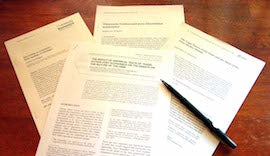 Publishing your academic writing in a journal is crucial to advancing your career. Standards are high, and you usually only get one shot, so don’t waste it. Here's how to make your paper the best it can be before submitting.
Publishing your academic writing in a journal is crucial to advancing your career. Standards are high, and you usually only get one shot, so don’t waste it. Here's how to make your paper the best it can be before submitting.
1. Read the journal
Just because a particular publication covers your field doesn’t necessarily mean that your article will be a good fit. Learn the aims of the particular publication, and then take it a step further by looking at the articles they choose to publish. If your article doesn’t seem like a good match, find a different publication to submit to or rewrite your article to make it more appropriate.
2. Find the article submission guidelines
You’ll find that different publications have different requirements, and if you don’t follow them, you risk having your academic writing thrown out before it’s even considered. It would be a shame not to be published just because you exceeded their word limit or submitted your document as the wrong file type. (This service can help reduce the size of a paper that is too long.)
3. Proofread, proofread, and then proofread again
It’s not enough just to run spellcheck or read through your work once. Getting a set of professional eyes on your work is ideal, since they’ll catch mistakes that you may not realize you made. If you’re interested in working with a professional proofreader, check out proofreading options here.
4. Review your bibliography
When proofreading, it can be easy to overlook this part of your paper, but it’s important to make sure it’s free of errors. Also, you want to ensure that all sources you cite in the text are included in the bibliography, and vice versa.
5. Verify you’ve included all the conventions of academic writing
Be sure to include a title, abstract, and keywords, and your paper should contain a clear statement of purpose in the introduction, lay out your hypotheses or the questions you are exploring, detail your methodology, provide a systematic analysis, and then discuss the results in the conclusion while acknowledging any limitations of the study.
6. Rework your title
It’s possible that the title you currently have is the best option, but more often than not, there’s a better one out there. You want the title to be accurate and descriptive. Look out for “filler” words and repetition. Take the time to brainstorm new ideas, and then get outside opinions to help you make a final selection.
7. Consult with colleagues in your field
The opinions of friends and family members are valuable, but this paper will be judged by someone who has in-depth knowledge of your area of study. Get an objective opinion before you submit your academic writing to a journal. Professors and other mentors are great resources for notes on how to improve your article. (Here is a list of consultants who can help as well.)
8. Get permission
Are you using any copyrighted material? Any piece of content you took from an outside source should be cited, and you need to obtain permission before submitting to a journal. Printing something as though you own it can come back to haunt your academic career in a big way. A plagiarism check is always a good idea.
9. Develop an effective cover letter
After spending all that time perfecting your academic writing, it can be tempting to throw together a cover letter quickly. This is a big mistake. You need this letter to be as compelling as possible because the editor may not get further than reading it. But that doesn’t mean it should be longwinded. Instead, keep it short and focused, just highlighting the key points. The goal is to entice them to read more. If you struggle writing cover letters, work with a consultant.
10. Look for supplemental material
Can you add more value to your academic writing? Are there tables, graphics, or other visual representations of the data that can help support your arguments? Some journals even accept multimedia, such as video or audio files, which they may include on their websites. It's always a good idea to get suggestions regarding artwork, tables, graphs, and other illustrations that could add value to your writing.
11. Call the editor
Even better than reading the journal to find out what they are looking for is having an actual conversation with the decision makers on the other end. Your enthusiasm and knowledge about the topic can help encourage the editor to take a look at a paper that he or she may otherwise not have considered. It’s also an opportunity to find more ways you can adjust your academic writing to be a better fit for the journal. If speaking with the editor isn't a possibility, at least consider speaking with experts in your field before submitting.
12. Present your paper at conferences
If you’re not sure where to submit, this can be a great path to finding a publication interested in your work. Instead of you seeking them out, they may come to you. Journal editors often attend conferences with the intent to find papers to publish.
If you’ve followed these twelve steps, you’ve done your best to prepare your academic writing for publication. Be aware that it can often take three to four months to hear back from journals, so don’t be discouraged if you aren’t contacted right away.
To see our full range of academic services, click here. We offer everything from translation to dissertation coaching to machine learning consulting.



Thant Zin says...
Really appreciate 12 steps for publication. Very informative and useful guide.
On April 01, 2019
Fakunle Emmanuel says...
Very informative, educative as well as helpful. It also sheds light on some of the reasons why many papers have hitch. Thank you very much.
On February 15, 2017
Latifa Jwieli says...
Thanks a lot. That is helpful.
On July 11, 2016
Mohamad Ary BY says...
Thank you Sir, it’s very helpful.
For next hopefully you can tell how to read journals quickly.
On May 23, 2016
Manish Jain says...
I strongly recommend this reading and thankful to Professor Poom Kumam for sharing the link and helping the researchers…
On April 22, 2016
Punit Bhatt says...
Very useful for beginners….
On April 19, 2016
Aida Elnabalawi says...
It’s very important steps to prepare articles
On April 06, 2016
Sanghamitra Kanjilal-Bhaduri says...
Very informative and helpful!
On April 03, 2016
Bini Balakrishnan says...
Thank you for the valuable tips. Would like to master in paper writing and publishing.
On April 02, 2016
lactin says...
Write an outline.
Use parallel structure.
Keep it as brief as possible.
On February 28, 2016
Tai-Jin Kim says...
Very concise and well summarized for manuscript to be accepted.
On February 27, 2016
Gitanjali says...
Useful Information.
On February 18, 2016
Engr BG says...
Very helpful and educative.
On February 16, 2016
Nurjannah yusuf says...
Its a great and inlighting information
On February 15, 2016
Loice Kipkiror says...
Great piece of information. Thank you. Highly appreciated. Bless
On February 14, 2016